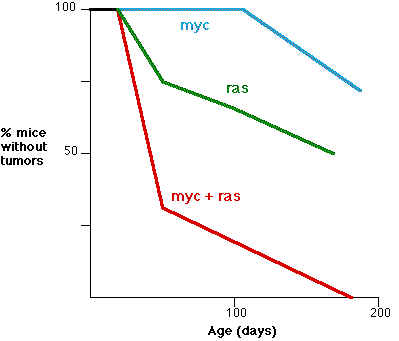An oncogene is a gene that
Cancer cells are cells that are engaged in uncontrolled mitosis.
Example: Epidermal Growth Factor (EGF).
Examples:
| Link to further discussion of receptor-activated kinases and their role in cancer. |
Examples: AP-1, a heterodimer of the proteins encoded by jun and fos.
Example: myc.
Example: the oncomouse: a transgenic mouse that has both copies of its myc gene under the influence of extra-powerful promoters.
All these oncogenes act as dominants; if the cell has one normal gene (called a proto-oncogene) and one mutated gene (the oncogene) at a pair of loci, the abnormal product takes control.
No single oncogene can, by itself, cause cancer. It can, however, increase the rate of mitosis of the cell in which it finds itself. Dividing cells are at increased risk of acquiring mutations, so a clone of actively dividing cells can yield subclones of cells with a second, third, etc. oncogene. When a clone loses all control over its mitosis, it is well on its way to developing into a cancer.
| Link to a discussion of the number and types of genetic "errors" needed to produce a full-blown cancer. |

This graph (based on the work of E. Sinn et al, Cell 49:465,1987) shows the synergistic effect of two oncogenes. The fraction (%) of transgenic mice without tumors is shown as a function of age. Three groups are shown:
The suicide of damaged cells — apoptosis — provides an important mechanism for ridding the body of cells that could go on to form a cancer.
It is not surprising then that inhibiting apoptosis can promote the formation of a cancer.
Example: Bcl-2. The product of this gene inhibits apoptosis. Overexpression of the gene is a hallmark of B-cell cancers. Link to a discussion.
Mutations arise from an unrepaired error in DNA. So any gene whose product participates in DNA repair probably can also behave as an oncogene when mutated.
| Link to discussion of DNA repair. |
Example: ATM. ATM (="ataxia telangiectasia mutated") gets its name from a human disease of that name, whose patients — among other things — are at increased risk of cancer. The ATM protein is also involved in detecting DNA damage and interrupting the cell cycle when damage is found.
It is estimated that fully 1% of the ~21,000 genes in the human genome are proto-oncogenes.
The products of some genes inhibit mitosis. These genes are called tumor suppressor genes. In contrast to oncogenes, these behave as recessives — both alleles must be defective to lose their braking effect on mitosis.
| Further discussion of Tumor-Suppressor Genes |
| Welcome&Next Search |